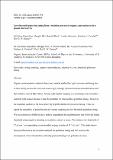Files in this item
Low threshold polariton lasing from a solution-processed organic semiconductor in a planar microcavity
Item metadata
| dc.contributor.author | Rajendran, Sai Kiran | |
| dc.contributor.author | Wei, Mengjie | |
| dc.contributor.author | Ohadi, Hamid | |
| dc.contributor.author | Ruseckas, Arvydas | |
| dc.contributor.author | Turnbull, Graham A. | |
| dc.contributor.author | Samuel, Ifor D. W. | |
| dc.date.accessioned | 2020-04-14T23:32:10Z | |
| dc.date.available | 2020-04-14T23:32:10Z | |
| dc.date.issued | 2019-06-18 | |
| dc.identifier | 258223895 | |
| dc.identifier | 11ee60ff-56bc-4fc5-ab4d-2d6381329bc8 | |
| dc.identifier | 85064515247 | |
| dc.identifier | 000471918700007 | |
| dc.identifier.citation | Rajendran , S K , Wei , M , Ohadi , H , Ruseckas , A , Turnbull , G A & Samuel , I D W 2019 , ' Low threshold polariton lasing from a solution-processed organic semiconductor in a planar microcavity ' , Advanced Optical Materials , vol. 7 , no. 12 , 1801791 , pp. 1-7 . https://doi.org/10.1002/adom.201801791 | en |
| dc.identifier.issn | 2195-1071 | |
| dc.identifier.other | ORCID: /0000-0001-9114-3522/work/56639036 | |
| dc.identifier.other | ORCID: /0000-0001-6418-111X/work/56639150 | |
| dc.identifier.other | ORCID: /0000-0002-9079-120X/work/100172724 | |
| dc.identifier.uri | https://hdl.handle.net/10023/19802 | |
| dc.description | Funding: UK EPSRC hybrid polaritonics program grant (EP/M025330/1) | en |
| dc.description.abstract | Organic semiconductor materials have been widely studied for light emission and lasing due to their ability to tune the emission wavelength through chemical structural modification and their relative ease of fabrication. Strong light-matter coupling is a promising route towards a coherent light source because it has the potential for thresholdless polariton lasing. However, the materials studied so far have relatively high thresholds for polariton lasing. Here we report the suitability of pentafluorene for strong coupling and low threshold polariton lasing. We use a protective buffer layer to reduce degradation during fabrication and lower the lasing threshold using negative detuning to maximize radiative decay. We obtain a low threshold of 17 µJ cm-2, corresponding to an absorbed energy density of 11.7 µJ cm-2. This study shows that pentafluorene is an attractive material for polariton lasing and will assist in the development of low threshold electrically pumped lasing from polariton devices. | |
| dc.format.extent | 7 | |
| dc.format.extent | 3646341 | |
| dc.language.iso | eng | |
| dc.relation.ispartof | Advanced Optical Materials | en |
| dc.subject | Low threshold | en |
| dc.subject | Microcavities | en |
| dc.subject | Organic semiconductors | en |
| dc.subject | Polariton lasing | en |
| dc.subject | Strong coupling | en |
| dc.subject | QC Physics | en |
| dc.subject | DAS | en |
| dc.subject.lcc | QC | en |
| dc.title | Low threshold polariton lasing from a solution-processed organic semiconductor in a planar microcavity | en |
| dc.type | Journal article | en |
| dc.contributor.sponsor | EPSRC | en |
| dc.contributor.institution | University of St Andrews. School of Physics and Astronomy | en |
| dc.contributor.institution | University of St Andrews. Condensed Matter Physics | en |
| dc.contributor.institution | University of St Andrews. Centre for Biophotonics | en |
| dc.identifier.doi | https://doi.org/10.1002/adom.201801791 | |
| dc.description.status | Peer reviewed | en |
| dc.date.embargoedUntil | 2020-04-15 | |
| dc.identifier.grantnumber | EP/M025330/1 | en |
This item appears in the following Collection(s)
Items in the St Andrews Research Repository are protected by copyright, with all rights reserved, unless otherwise indicated.

